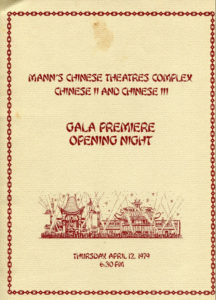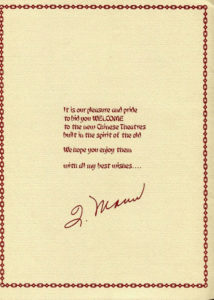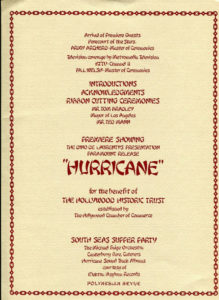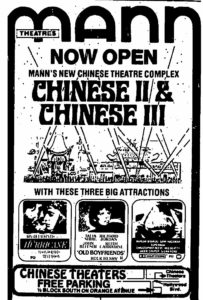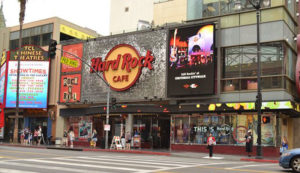“Forgotten” would seem to be an unlikely moniker for a cinema directly associated with the most famous movie theatre in the world. However, that proved to be the fate of Mann’s Chinese 2 & 3 (aka Mann’s Chinese Twin). Envisioned as a moviegoing mecca, built as a modern take on a classic, and falling victim to its’ famous location, Mann’s Chinese Twin is the subject of our latest exploration into Forgotten Cinema.
After purchasing the National General theatre circuit in 1973, Ted Mann embarked on an aggressive and somewhat controversial new course for the long struggling company. Rebranding under his name, Mann sought to modernize the ageing chain via new multiplex builds and “plexing” of many classic single screens in the company’s portfolio. Within a few years, this business plan succeeded in turning an underperforming 276 screens into a thriving regional juggernaut of over 400. Yet, there remained one perceived need in Mann’s growing cinema empire. The company’s flagship, rechristened Mann’s Chinese Theatre, did not exemplify this new direction.
Fortunately, Ted Mann both cherished the significance of the Chinese Theatre and recognized that “plexing” the grand venue would be counterproductive. Instead, he proposed building an addition, or sister venue, on the theatre’s eastern parking lot, creating a multiscreen moviegoing mecca. This new Chinese complex would instill an efficient multiplex business model, add modern amenities, and expand on the drawing power of the original theatre. Initial plans called for as many as five auditoriums, replicating a standard Mann multiplex beside the classic palace. However, Mann ultimately chose to “go big” and attempt to live up to the Chinese’s prestigious reputation.
Acquiring the services of noted theatre consultant Mel Glatz, Mann invested $3 million into building a twin plex which would combine the function of modern cinemas with the “flavor” of the neighboring Chinese. The planning stage saw Mr. Glatz spending six months on architectural research and the creation of over forty volumes of notes and sketches. According to accounts from the time, the greatest obstacle proved to be the lack of craftsmen who could duplicate much of what Glatz envisioned, as the skills which had been behind the original Chinese’s artistry were out of feasible financial reach for a contemporary project. In the end, a compromise of modern methods and materials was reached to achieve an artisan look.
Opened on 4/12/1979, with a $50 per person screening of Dino De Laurentis’ “Hurricane”, Mann’s Chinese 2 & 3 was hailed as a “spectacular blend of new and old”. Featuring 21,000 square feet of floor space, two 750 seat auditoriums (some accounts list 750 & 650), 70mm projection, four & six track stereo with Dolby sound, and “voice of the theatre” speakers, the Twin far exceeded multiplex standards of the day. Honoring the theatre’s heritage, the venue also included hand painted silk murals, decorative lacquered white oak screens, and pewter art panels; to accompany the overall “classic Chinese design adapted to contemporary usage”. Seeking a formal link to the original Chinese, the Twin installed a large glass display enclosure which housed several Grauman artifacts, including some of the 1927 Stubergh wax figures. Reflecting on the spirit of his latest offering, Ted Mann commented, “expansion is our life blood, but history is our soul.”
While launched with much fanfare and, initially, drawing sizeable audiences, the Chinese Twin’s glory days were short lived. Faced with Hollywood Boulevard’s ever worsening reputation and overshadowed by the adjacent Chinese Theatre, the Twin soon fell out of favor with moviegoers. The chaotic daytime tourist scene and evening’s high crime rate deterred locals. Those making a longer trek favored the original Chinese for their effort. In short order, the intended complex came to be viewed as the legendary Chinese and its’ lesser alternative. Finding more success as a site for smaller premieres and special screenings, than as a day to day cinema, the Twin never quite lived up to Ted Mann’s vision for a moviegoing mecca.
By the close of the 1980’s, Ted Mann had moved on from his namesake chain and a revolving door of new owners initiated a downward spiral of poor decision making. Meanwhile, local civic leaders had turned their attention towards revitalizing Hollywood Boulevard and the Chinese Twin property became a frequent target for redevelopment proposals. As early as 1985, developers had laid out plans for a Hollywood Prominade project to replace the Twin and remaining western parking lot. A latter proposal suggested supplanting the Twin with a shopping plaza and building an IMAX attraction on the western parking lot. Then, in March of 1997, Toronto based Trizec Hahn Corp unveiled plans for a Community Redevelopment Agency backed retail and entertainment complex on the site. Quietly closed and demolished in 1999, the Twin made way for the $385 million Hollywood & Highland Center; the former location of the theatre being the area which now houses the TCL Chinese box office, Hardrock Café restaurant, and, in a bit of cyclical history, the upper level Chinese 6 theatre.
Today, Mann’s Chinese Twin is little more than a fuzzy memory or seldom recounted side story in the history of Grauman’s Chinese Theatre, with even pictures of the venue being somewhat scarce (check out Bill Counter’s site for a few). Intended as a means of capitalizing on the world’s most famous theatre, the Twin was ultimately forgotten under the shadow of that fame.
Tags: No Comments


